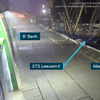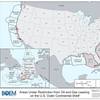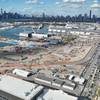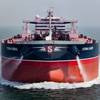Hydrex Completes Underwater Propeller Modification in Cadiz
When a 590.5 ft container vessel suffered severe vibrations after its propeller blades were seriously damaged, a repair was required by the classification society. Hydrex was asked to bring the propeller’s performance as close to its optimum performance as could be achieved while the vessel was berthed in Cadiz.
The in-house developed Hydrex cold straightening machines were mobilized from the Hydrex headquarters in Antwerp. At the same time a diver-technician team left the office in Algeciras, together with the rest of the equipment, to attend to the ship in Cadiz.
Soon they arrived at the vessel and set up a monitoring station on shore. To make a full assessment of the damage, the team first performed a detailed underwater inspection of the blades which revealed that the damage was caused by a mooring rope that had been caught in the propeller. It also became clear that one blade could be straightened and that two blades needed to be cropped because the damage was too extensive. The fourth blade had unfortunately been bent in such a way that the danger of cracks occurring during the repair was too great to risk. Because replacing only one blade of this fixed propeller was not possible, it was decided to leave the blade as it was and minimize the vibration by performing the repair on the other three blades.
The information acquired was then used to determine the correct measurements needed for the cropping and cold straightening. After the necessary calculations had been made, blade n° 1 was straightened back to its original position. Next the area to be cropped was marked out on blades n° 2 and 4 and verified. The blades were then cropped and their edges grinded to give them the correct radius. When the cropping was complete, the blades were polished to make sure that any remaining loss of efficiency would be minimal. After the repair tests were performed by the class, the vessel was allowed to sail on without condition of class.
The combined cold straightening and cropping within the available timeframe. The propeller’s balance could be restored and its hydrodynamic efficiency restored as close to its optimum condition as possible.











